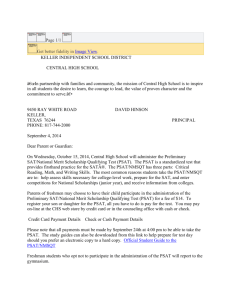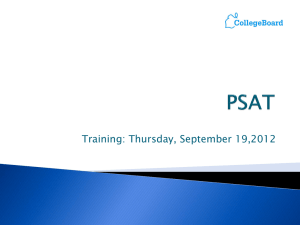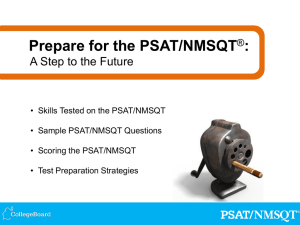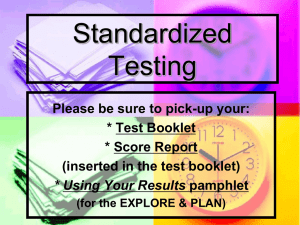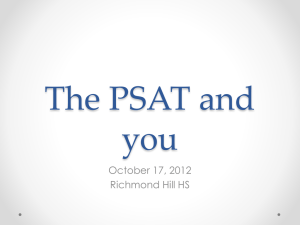PSAT/NMSQT - LHS PSAT Team - Home
advertisement
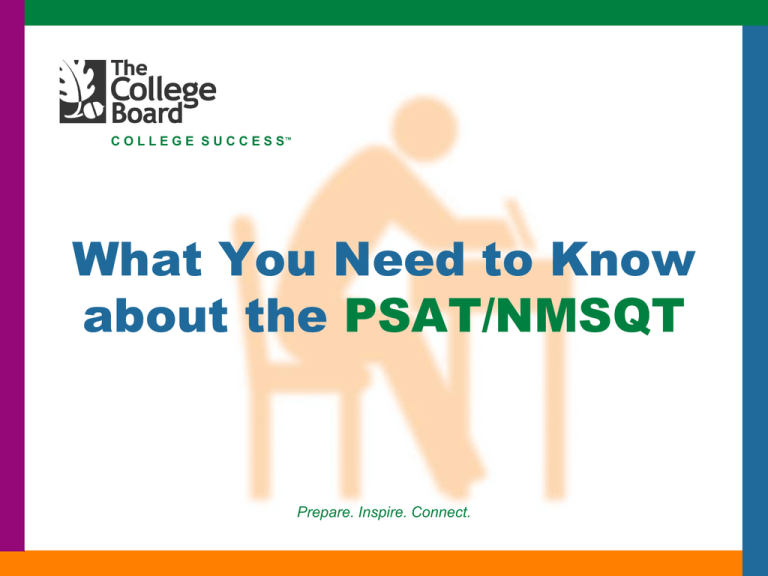
C O L L E G E S U C C E S S™ What You Need to Know about the PSAT/NMSQT Prepare. Inspire. Connect. What is the PSAT/NMSQT? • Preliminary SAT – College Entrance Exam • Tests of: Critical Reading Mathematics Writing • National Merit Scholarship Qualifying Test when taken in 11th grade • Closely related to skills students will need to succeed in college Why take the PSAT/NMSQT? • Excellent preparation for college entrance exams (SAT, ACT) and for college in general. • Colleges use PSAT scores for potential recruitment • Identification for potential scholarships and awards • National Merit Scholarship Program • National Merit Semifinalist • Commended Scholar • National Hispanic Scholar • National Achievement Scholarship Program for Outstanding African American Students • May other academic scholarships available. Look at our website! Time Frame for taking PSAT/NMSQT 9th and 10th grade years (All LHS students take for practice) • Your sophomore score is what qualified you for the PSAT team!! 11th grade year • October 17, 2012: PSAT/NMSQT (The PSAT Team will do AWESOME on the PSAT!) • December 1, 2012: Recommended date that students should register for SAT Item Specifications PSAT/NMSQT Critical Reading Time Questions 2 hours 10 minutes Number/Type of Questions Section 1: 25 minutes Section 3: 25 minutes Section 1: 8 sentence completion; 16 passage-based reading Section 3: 5 sentence completion; 19 passage-based reading Section 2: 25 minutes Section 2: 20 mc questions Section 4: 25 minutes Section 4: 8 mc questions; 10 grid-in questions Section 5: 30 minutes Section 5: 14 identifying sentence errors; 20 improving sentences; 5 improving paragraphs Math Writing How is the PSAT Scored? • 1 point for each correct response. • Subtract ¼ point for each incorrect response. • Skipped questions are not counted at all. • You will see how the grading works exactly in a few minutes when you grade your test from yesterday. Guessing • Scoring is designed so that random guessing should neither help nor hurt your score. • However, if you have no idea, it is probably best just to move on and skip the problem. • If you can eliminate even one answer choice it is probably best to go ahead and make a guess. • For more information on guessing, including specific examples, see the guessing document on our PSAT Team website: LHSPSATTeam.weebly.com Difference on Writing (SAT and PSAT) • In addition to the types of writing questions on the PSAT, the SAT includes a writing prompt and written essay. • The essay will be similar to the type of on-demand writing that is typically done in college. • Many colleges began requiring a standardized writing test for admission beginning with the entering class of 2006. When will I get my PSAT scores back? • Scores usually arrive in mid-December • You will receive a Skills Feedback document at school • The Score Report will show three columns • Math, Critical Reading, and Writing • Range score from 0-80 Skills Feedback Score Report Plus Maximum score of 80 for each section Contains access code for a free program called My College Quickstart with a more detailed score report, a personalized study plan and college planning tools. Skills Feedback Score Report Plus • Tells students how their scores compare to those of other sophomores or juniors • Tells students what SAT score ranges they can expect • Includes a question-by-question breakdown • Helps students identify strengths and weaknesses and provides tips on how to improve specific skills General Test Taking Approaches • Answer easy questions first. The easier questions are usually at the start of the section, and the harder ones are at the end. The exception is in the critical reading section, where questions are ordered according to the logic and organization of each passage. • Make educated guesses. If you can rule out one or more answer choices for multiple-choice questions, you have a better chance of guessing the right answer. • Skip questions that you really can't answer. No points are deducted if an answer is left blank. • Limit your time on any one question. All questions are worth the same number of points. If you need a lot of time to answer a question, go on to the next one. Later, you may have time to return to the question you skipped. General Test Taking Approaches • Keep track of time. Don't spend too much time on any group of questions within a section. • Use your test booklet as scratch paper. • Mark the questions in your booklet that you skipped and want to return to. • Check your answer sheet to make sure you are answering the right question. • Make sure you use a No. 2 pencil. It is very important that you fill in the entire circle on the answer sheet darkly and completely. If you change your response, erase it as completely as possible. • Calculator. Use one with which you are familiar. There is no “best” calculator for PSAT. You just want one you are comfortable with so it doesn’t take time to figure out the calculator while you are testing. The PSAT Team • We are so excited to have all of you on this unique team. While the material might lack excitement at times, hopefully the improvement in your confidence and PSAT score will make the hard work well worth it! As the PSAT Team Class progresses, you will get more detailed information about the following: • Class logistics (your grade for the class, what we will do) • Important dates • Specific information for each section you will face on the PSAT • Much, much more!
